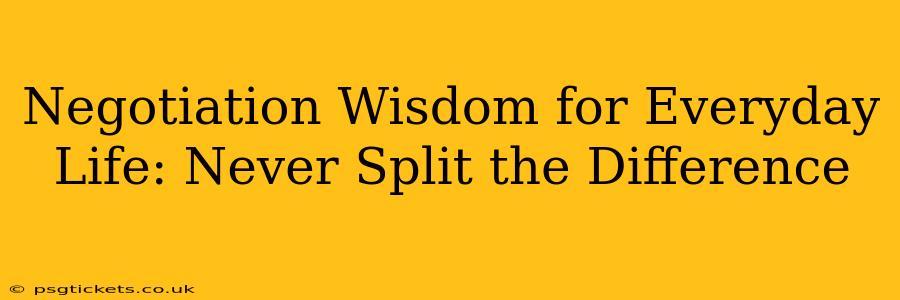Negotiation. The word itself can conjure images of tense boardroom meetings, high-stakes legal battles, or even tense family discussions. But the truth is, negotiation is a fundamental skill applicable to virtually every aspect of our daily lives, from securing a better price at a flea market to navigating complex professional relationships. Chris Voss's groundbreaking book, Never Split the Difference, offers a powerful framework for mastering this crucial life skill, transforming seemingly intractable situations into mutually beneficial outcomes. This post will delve into the core principles of his approach, exploring how you can leverage them in your everyday interactions.
What is "Never Split the Difference"?
The core principle behind Never Split the Difference is simple yet profound: don't aim for a compromise, aim for a collaborative solution. Voss, a former FBI hostage negotiator, argues that traditional negotiation tactics—like haggling over numbers—often lead to unsatisfactory results. Instead, he emphasizes the importance of building rapport, understanding the other party's perspective, and employing tactical communication techniques to achieve a win-win scenario.
Key Tactics from "Never Split the Difference" for Everyday Life
Voss's techniques aren't just for high-stakes scenarios. They are adaptable tools for everyday negotiations. Let's explore some key takeaways:
1. Tactical Empathy: Understanding the Other Side
What is it? This involves actively listening to understand the other person's needs, fears, and motivations, even if you don't agree with them. It's about stepping into their shoes, not to agree, but to understand.
How to use it: Practice active listening. Use mirroring (repeating their last few words) and labeling (naming their emotions). For example, "So it sounds like you're feeling frustrated because..."
2. The Power of Questions: Guiding the Conversation
What is it? Instead of making statements, use carefully crafted questions to guide the conversation and uncover the other party's underlying interests. Open-ended questions starting with "what," "how," and "why" are especially effective.
How to use it: Avoid "yes/no" questions. Instead of asking, "Do you want to meet on Tuesday?" try, "What day works best for you to meet?"
3. Mirroring and Labeling: Building Rapport and Trust
What is it? Mirroring involves subtly mimicking the other person's body language or tone of voice to create a subconscious connection. Labeling is identifying their emotions ("It sounds like you're feeling stressed about this").
How to use it: Pay attention to their nonverbal cues. Try subtly mirroring their posture or pace of speech. Use labels to acknowledge their feelings.
4. Calibrated Questions: Uncovering Hidden Information
What is it? These are questions designed to elicit specific information or perspectives, often used to uncover unspoken concerns or objections.
How to use it: For example, instead of directly asking for a discount, you could ask, "What would make this deal work for you?"
5. "That's Right" Technique: Gaining Agreement and Building Consensus
What is it? This involves affirming the other party's statements, even if you don't completely agree, to build rapport and create a collaborative environment.
How to use it: Instead of arguing, simply say, "That's right," "That's correct," or "I understand."
Addressing Common Questions about Negotiation
How can I negotiate a better salary?
Research industry standards, highlight your accomplishments, and practice your negotiation strategy beforehand. Remember to focus on the value you bring to the company. Utilize calibrated questions to understand their budget constraints and find common ground.
How do I negotiate with difficult people?
Maintain your composure, focus on their underlying needs, and use empathy to understand their perspective. Remember, their difficult behavior often stems from fear or insecurity.
Can I use these techniques in personal relationships?
Absolutely! These techniques can help improve communication and resolve conflicts in family, friend, and romantic relationships. Focus on empathy and understanding to build stronger bonds.
Conclusion: The Power of Negotiation in Everyday Life
Mastering the art of negotiation is not about winning or losing; it's about finding mutually beneficial solutions. By incorporating the principles outlined in Never Split the Difference, you can navigate everyday interactions with greater confidence, achieving more favorable outcomes in both your personal and professional life. Remember that effective negotiation is a skill that develops over time with practice and conscious application. Start small, practice these techniques, and observe the positive changes in your interactions.

